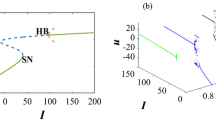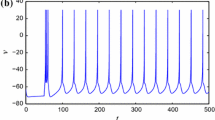Abstract
Fractional-order derivatives have been widely used to describe the spiking patterns of neurons, without considering their self-similar dendritic structures. In this study, a self-similar resistor–capacitor network is proposed to relate the spiny dendritic structure with fractional spiking properties. In order to achieve this goal, two types of networks comprising recursively staggered resistors and capacitors were developed to model the functional properties of smooth and spiny dendrites, respectively. Their overall electrotonic properties can be described by fractional order temporal operators derived by Heaviside operational calculus. According to this operator method, spiking patterns of spiny dendrites were controlled by the standard 0.5-order derivative, whereas an exponential modulation term was added in the governing fractional operator of the smooth dendrites. The application of these fractional operators in a leaky integrate-and-fire model reveals that the dendritic spine plays an important role in alternations of the spiking properties, including first-spike latency, firing rate adaptation, and afterhyperpolarization conductance. Further, the multilevel assembly of this network indicates that the fractional spiking behaviors of spiny neurons might originate from their hierarchical substructures, thereby highlighting possible functional consequences of alterations to dendritic self-similarity.










Similar content being viewed by others
References
La Camera, G., Rauch, A., Thurbon, D., Lüscher, H.R., Senn, W., Fusi, S.: Multiple time scales of temporal response in pyramidal and fast spiking cortical neurons. J. Neurophysiol. 96(6), 3448–3464 (2006)
Lundstrom, B.N., Higgs, M.H., Fairhall, A.L., Spain, W.J., Fairhall, A.L.: Fractional differentiation by neocortical pyramidal neurons. Nat. Neurosci. 11(11), 1335–1342 (2008)
Chaudhuri, R., Knoblauch, K., Gariel, M.A., Kennedy, H., Wang, X.J.: A large-scale circuit mechanism for hierarchical dynamical processing in the primate cortex. Neuron 88(2), 419–431 (2015)
Joglekar, M.R., Mejias, J.F., Yang, G.R., Wang, X.J.: Inter-areal balanced amplification enhances signal propagation in a large-scale circuit model of the primate cortex. Neuron 98(1), 222–234.e8 (2018)
Higgs, M.H., Slee, S.J.: Diversity of gain modulation by noise in neocortical Neurons: regulation by the slow afterhyperpolarization conductance. J. Neurosci. 26(34), 8787–8799 (2006)
Lundstrom, B.N., Fairhall, A.L., Maravall, M.: Multiple timescale encoding of slowly varying whisker stimulus envelope in cortical and thalamic neurons in vivo. J. Neurosci. 30(14), 5071–5077 (2010)
Scutt, G., Allen, M., Kemenes, G., Yeoman, M.: A switch in the mode of the sodium/calcium exchanger underlies an age-related increase in the slow afterhyperpolarization. Neurobiol. Aging 36(10), 2838–2849 (2015)
Disterhoft, J.F., Wu, W.W., Ohno, M.: Biophysical alterations of hippocampal pyramidal neurons in learning, ageing and Alzheimer’s disease. Ageing Res. Rev. 3(4), 383–406 (2004)
Podlubny, I.: Fractional Differential Equations. Academic Press, San Diego (1999)
Ionescu, C., Lopes, A., Copot, D., Machado, J.A.T., Bates, J.H.T.: The role of fractional calculus in modeling biological phenomena: a review. Commun. Nonlinear Sci. Numer. Simul. 51, 141–159 (2017)
Deseri, L., Di Paola, M., Zingales, M., Pollaci, P.: Power-law hereditariness of hierarchical fractal bones. Int. J. Numer. Methods Biomed. 29(12), 1338–1360 (2013)
Deseri, L., Pollaci, P., Zingales, M., Dayal, K.: Fractional hereditariness of lipid membranes: instabilities and linearized evolution. J. Mech. Behav. Biomed. Mater. 58, 11–27 (2016)
Guo, J., Yin, Y., Ren, G.: Abstraction and operator characterization of fractal ladder viscoelastic hyper-cell for ligaments and tendons. Appl. Math. Mech. Engl. Ed. 40(10), 1429–1448 (2019)
Perdikaris, P., Karniadakis, G.E.: Fractional-order viscoelasticity in one-dimensional blood flow models. Ann. Biomed. Eng. 42(5), 1012–1023 (2014)
Mondal, A., Upadhyay, R.K.: Diverse neuronal responses of a fractional-order Izhikevich model: journey from chattering to fast spiking. Nonlinear Dyn. 91(2), 1275–1288 (2018)
Meng, F., Zeng, X., Wang, Z.: Dynamical behavior and synchronization in time-delay fractional-order coupled neurons under electromagnetic radiation. Nonlinear Dyn. 95(2), 1615–1625 (2019)
Paola, M.D., Zingales, M.: Exact mechanical models of fractional hereditary materials. J. Rheol. 56(5), 983–1004 (2012)
Butera, S., Di Paola, M.: A physically based connection between fractional calculus and fractal geometry. Ann. Phys. 350, 146–158 (2014)
Di Paola, M., Pinnola, F.P., Zingales, M.: Fractional differential equations and related exact mechanical models. Comput. Math. Appl. 66(5), 608–620 (2013)
Teka, W., Marinov, T.M., Santamaria, F.: Neuronal spike timing adaptation described with a fractional leaky integrate-and-fire model. PLoS Comput. Biol. 10(3), 1–14 (2014)
Shi, M., Wang, Z.: Abundant bursting patterns of a fractional-order Morris–Lecar neuron model. Commun. Nonlinear Sci. Numer. Simul. 19(6), 1956–1969 (2014)
Weinberg, S.H.: Membrane capacitive memory alters spiking in neurons described by the fractional-order Hodgkin–Huxley model. PLoS ONE 10(5), 1–27 (2015)
Teka, W., Stockton, D., Santamaria, F.: Power-law dynamics of membrane conductances increase spiking diversity in a Hodgkin–Huxley model. PLoS Comput. Biol. 12(3), 1–23 (2016)
Upadhyay, R.K., Mondal, A., Teka, W.W.: Fractional-order excitable neural system with bidirectional coupling. Nonlinear Dyn. 87(4), 2219–2233 (2017)
Mankin, R., Paekivi, S.: Memory-induced resonancelike suppression of spike generation in a resonate-and-fire neuron model. Phys. Rev. E 97(1), 12125 (2018)
van Ooyen, A., Duijnhouwer, J., Remme, M.W.H., van Pelt, J.: The effect of dendritic topology on firing patterns in model neurons. Netw. Comput. Neural Syst. 13(3), 311–325 (2002)
van Elburg, R.A.J., van Ooyen, A.: Impact of dendritic size and dendritic topology on burst firing in pyramidal cells. PLoS Comput. Biol. 6(5), e1000781 (2010)
de Sousa, G., Maex, R., Adams, R., Davey, N., Steuber, V.: Dendritic morphology predicts pattern recognition performance in multi-compartmental model neurons with and without active conductances. J. Comput. Neurosci. 38(2), 221–234 (2015)
Mainen, Z.F., Sejnowski, T.J.: Influence of dendritic structure on firing pattern in model neocortical neurons. Nature 382(6589), 363–366 (1996)
Henry, B.I., Langlands, T.A.M., Wearne, S.L.: Fractional cable models for spiny neuronal dendrites. Phys. Rev. Lett. 100(12), 128103 (2008)
Nimchinsky, E.A., Sabatini, B.L., Svoboda, K.: Structure and function of dendritic spines. Annu. Rev. Physiol. 64(1), 313–353 (2002)
Martin, K.A.C., Douglas, R.J., Binzegger, T.: Axons in cat visual cortex are topologically self-similar. Cereb. Cortex 15(2), 152–165 (2004)
Smith, T.G., Lange, G.D., Marks, W.B.: Fractal methods and results in cellular morphology—dimensions, lacunarity and multifractals. J. Neurosci. Methods 69(2), 123–136 (1996)
Fernández, E., Jelinek, H.F.: Use of fractal theory in neuroscience: methods, advantages, and potential problems. Methods 24(4), 309–321 (2001)
Rothnie, P., Kabaso, D., Hof, P.R., Henry, B.I., Wearne, S.L.: Functionally relevant measures of spatial complexity in neuronal dendritic arbors. J. Theor. Biol. 238(3), 505–526 (2006)
Mandelbrot, B.B., Vicsek, T.: Directed recursion models for fractal growth. J. Phys. A Math. Theor. 22(9), L377 (1989)
Puškaš, N., Zaletel, I., Stefanović, B.D., Ristanović, D.: Fractal dimension of apical dendritic arborization differs in the superficial and the deep pyramidal neurons of the rat cerebral neocortex. Neurosci. Lett. 589(88), 88–91 (2015)
Baer, S.M., Rinzel, J.: Propagation of dendritic spikes mediated by excitable spines: a continuum theory. J. Neurophysiol. 65(4), 874–890 (1991)
Mikusinski, J.: Operational Calculus, 2nd edn. Pergamon Press, Oxford (1983)
Cartea, Á., Del-Castillo-Negrete, D.: Fluid limit of the continuous-time random walk with general Lévy jump distribution functions. Phys. Rev. E 76(4), 41105 (2007)
Cao, J., Li, C., Chen, Y.: On tempered and substantial fractional calculus. In: 2014 IEEE/ASME 10th International Conference on Mechatronic and Embedded Systems and Applications (MESA), pp. 1–6 (2014)
Chen, M., Deng, W.: Discretized fractional substantial calculus. ESAIM Math. Model. Numer. Anal. 49(2), 373–394 (2015)
Li, C., Deng, W.: High order schemes for the tempered fractional diffusion equations. Adv. Comput. Math. 42(3), 543–572 (2016)
Friedrich, R., Jenko, F., Baule, A., Eule, S.: Anomalous diffusion of inertial, weakly damped particles. Phys. Rev. Lett. 96(23), 230601 (2006)
Sabzikar, F., Meerschaert, M.M., Chen, J.: Tempered fractional calculus. J. Comput. Phys. 293, 14–28 (2015)
Ding, H., Li, C.: A high-order algorithm for time-Caputo-tempered partial differential equation with Riesz derivatives in two spatial dimensions. J. Sci. Comput. 80(1), 81–109 (2019)
Santamaria, F., Wils, S., De Schutter, E., Augustine, G.J.: Anomalous diffusion in Purkinje cell dendrites caused by spines. Neuron 52(4), 635–648 (2006)
Metzler, R., Klafter, J.: The random walk’s guide to anomalous diffusion: a fractional dynamics approach. Phys. Rep. 339(1), 1–77 (2000)
Oldham, K.B.: The Fractional Calculus Theory and Applications of Differentiation and Integration to Arbitrary Order. Academic Press, New York, NY (1974)
Marinov, T., Nelson, R., Fidel, S.: Fractional integration toolbox. Fract. Calc. Appl. Anal. 16, 670–681 (2013)
Heil, P.: First-spike latency of auditory neurons revisited. Curr. Opin. Neurobiol. 14(4), 461–467 (2004)
Ikeda, M., Hojo, Y., Komatsuzaki, Y., Okamoto, M., Kato, A., Takeda, T., Kawato, S.: Hippocampal spine changes across the sleep-wake cycle: corticosterone and kinases. J. Endocrinol. 226(2), M13–M27 (2015)
Maravall, M., Petersen, R.S., Fairhall, A.L., Arabzadeh, E., Diamond, M.E.: Shifts in coding properties and maintenance of information transmission during adaptation in barrel cortex. PLoS Biol. 5(2), e19 (2007)
Segev, I., London, M.: Untangling dendrites with quantitative models. Science 290(5492), 744–750 (2000)
Suetsugu, M., Mehraein, P.: Spine distribution along the apical dendrites of the pyramidal neurons in Down’s syndrome. Acta Neuropathol. 50(3), 207–210 (1980)
Jacobs, B., Driscoll, L., Schall, M.: Life-span dendritic and spine changes in areas 10 and 18 of human cortex: a quantitative Golgi study. J. Comp. Neurol. 386(4), 661–680 (1997)
Duan, H., Wearne, S.L., Rocher, A.B., Macedo, A., Morrison, J.H., Hof, P.R.: Age-related dendritic and spine changes in corticocortically projecting neurons in Macaque monkeys. Cereb. Cortex 13(9), 950–961 (2003)
Zador, M., Diego, S., Zador, A.M., Agmon-Snir, H., Segev, I.: The morphoelectrotonic transform: a graphical approach to dendritic function. J. Neurosci. 15(3), 1669–1682 (1995)
Cafagna, D., Grassi, G.: On the simplest fractional-order memristor-based chaotic system. Nonlinear Dyn. 70(2), 1185–1197 (2012)
Si, G., Diao, L., Zhu, J.: Fractional-order charge-controlled memristor: theoretical analysis and simulation. Nonlinear Dyn. 87(4), 2625–2634 (2017)
Yang, N., Xu, C., Wu, C., Jia, R., Liu, C.: Fractional-order cubic nonlinear flux-controlled memristor: theoretical analysis, numerical calculation and circuit simulation. Nonlinear Dyn. 97(1), 33–44 (2019)
Acknowledgements
We thank Yiheng Han and Yuhao Sun for the helpful discussion on this topic. This research was partially supported by the National Natural Science Foundation of China (Grant Nos. 61836014, 11672150).
Author information
Authors and Affiliations
Corresponding author
Ethics declarations
Conflict of interest
The authors declare that they have no conflict of interest with regard to the publication of this manuscript.
Additional information
Publisher's Note
Springer Nature remains neutral with regard to jurisdictional claims in published maps and institutional affiliations.
Rights and permissions
About this article
Cite this article
Guo, J., Yin, Y., Hu, X. et al. Self-similar network model for fractional-order neuronal spiking: implications of dendritic spine functions. Nonlinear Dyn 100, 921–935 (2020). https://doi.org/10.1007/s11071-020-05519-4
Received:
Accepted:
Published:
Issue Date:
DOI: https://doi.org/10.1007/s11071-020-05519-4




